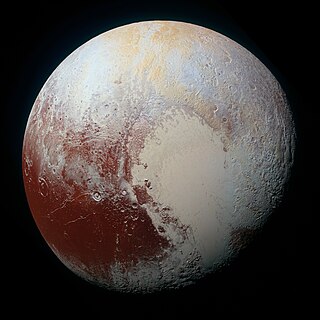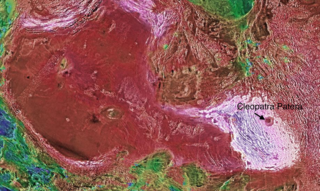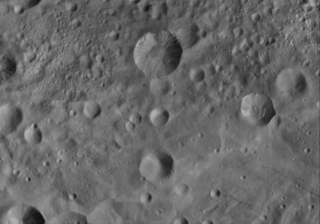Related Research Articles

Planetary nomenclature, like terrestrial nomenclature, is a system of uniquely identifying features on the surface of a planet or natural satellite so that the features can be easily located, described, and discussed. Since the invention of the telescope, astronomers have given names to the surface features they have discerned, especially on the Moon and Mars. To found an authority on planetary nomenclature, the International Astronomical Union (IAU) was organized in 1919 to designate and standardize names for features on Solar System bodies.
Terra may often refer to:
This is a directory of lists of geological features on planets excepting Earth, moons and asteroids ordered by increasing distance from the Sun.

Ishtar Terra is the second largest of the three continental terrae regions on the planet Venus, the others being Aphrodite Terra and Lada Terra.

Aphrodite Terra is one of the three continental regions on the planet Venus, the others being Ishtar Terra and Lada Terra. It is named for Aphrodite, the Greek equivalent of the goddess Venus, and is found near the equator of the planet. Aphrodite Terra is about half the size of Africa, making it the largest of the terrae.

Lakshmi Planum is a plateau feature approximately 2 million km2 ringed by rugged mountains, the surface of Venus on the Western Ishtar Terra. It is named after Lakshmi, the Hindu goddess of wealth.

Tempe Terra is a heavily cratered highland region in the northern hemisphere of the planet Mars. Located at the northeastern edge of the Tharsis volcanic province, Tempe Terra is notable for its high degree of crustal fracturing and deformation. The region also contains many small shield volcanoes, lava flows, and other volcanic structures.
Nanichi is a crater found the Magellian region on the planet Venus. It measures 19 km in diameter, and is located at +East, 0 - 360 using the planetocentric coordinate system.

Lada Terra, named for a Slavic goddess of Love, is a major landmass near the south pole of Venus which is centered at 60°S and 20°E and has a diameter of 8,615 kilometres (5,353 mi). It is defined by the International Astronomical Union as one of the three "major landmasses," or terrae, of Venus. The term "landmass" is not analogous to the landmass on Earth, as there are no apparent oceans on Venus. The term here applies to a substantial portion of land that lies above the average planetary radius, and corresponds to highlands.
Eridania Planitia is a plain located in the southern highlands of Mars. It borders the Hellas basin to the west, Promethei Terra to the south, and the massive shield volcano Hesperia Planum to the north. The name Eridania Planitia was approved by the International Astronomical Union (IAU) on 22 September 2010; it is named after the closest classical albedo feature.

Skadi Mons is a mountain on Venus in Maxwell Montes, at the center of Ishtar Terra. It is the highest point on the planet, with an altitude of about 10,700 meters above the mean planetary radius.
The following outline is provided as an overview of and topical guide to Venus:
Xcacau Corona is a corona in the planet Venus, in the coordinates -56 ° S and 131 ° E.

Nott Corona is a corona, a geological formation in the shape of a crown, located on the planet Venus at -32.3° N and 202° E. It is located in the Isabella quadrangle. It is named after Nótt, the Scandinavian goddess of the Earth.

Vestalia Terra is a large highland plateau on the giant asteroid Vesta. Situated in Vesta's eastern hemisphere, Vestalia Terra is located near the equator and hosts the tallest point on Vesta. One of the largest named features on Vesta, it contains some of the most ancient terrain known on the asteroid. Additionally, Vestalia Terra is one of the few remaining magmatic features discovered on Vesta.
References
- This list was adapted from the Gazetteer of Planetary Nomenclature